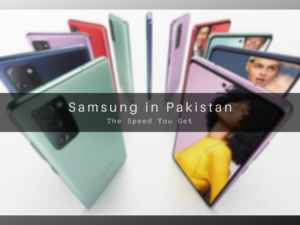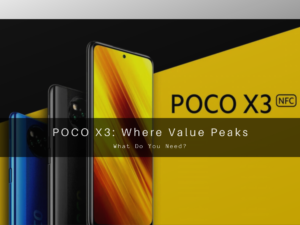Do these claims sound familiar?
- 48MP Main Camera
- 144Hz Display
- 6000 mAh battery
- 100W Fast Charging
- 108MP Ultra Camera
The saturation in the smartphone market has resulted in what can be called the big numbers game. Every day you will see brands like Redmi, Oppo, or even Samsung come up with new ways to advertise the big numbers on their products only to go back after realizing the flaws. The Samsung Galaxy S20 Ultra 5G is the perfect example of why big numbers often don’t mean the best results. The 108MP camera on the said phone was infamously inefficient at focusing on subjects to the point that in many situations all reviewers agreed to prefer the lesser S20 variant over the top-of-the-line model. Another example of such reduction is seen in the new screen resolution offered in the Samsung Galaxy S21, the latest offering by Samsung now has a screen resolution density of 421 ppi compared to their very own Samsung Galaxy S4 from 2013 having a density of 441 ppi. Another great example is of the Xiaomi PocoPhone X3 NFC which boasted a 120Hz fast display only to result in a hiccup-y user experience, with the brand now focusing more towards a higher quality display rather than the gimmicky speed with their latest release of Redmi Note 10.
Countless examples can be seen where companies claim big numbers and then shy away from all their prior marketing tactics. There are also many examples of companies taking advantage of a market at their disposal such as Samsung’s offering with the Exynos chipset. At the end of the day, what differentiates a good smartphone from a bad smartphone all comes down to the user experience being offered; and there is a reason why brands like Apple and OnePlus lead the charts in this domain.
Curved Screens & Empty Pockets
You must have wondered why holding a curved screen display phone with your hand feels strange and out of place? Ever thought this happens mainly because the palm of your hand is constantly in contact with the sides of the screen which usually results in multiple accidental palm touches. Plus the screen protectors are way overpriced, dull, and just plain annoying.
It doesn’t stop here; the curved screens are so a high-maintenance luxury and are more expensive to repair as compared to a flat-screen. Take a look at the overly priced screen protectors that aren’t even aesthetically pleasing. I mean, what is even a 9D protector? we used to have simple plastic or glass screen protectors and now the market seems to be flooded with 9D, Jelly, UV screen protectors.
Though it plays a vital role in elevating the premium feel of a device, giving it that super-sleek futuristic look the usability and the functionality should take more precedence. The current smartphones with curved displays such as Oppo Reno 3 Pro, OnePlus 8, Xiaomi Mi 10 are more fragile and prone to breakage from dropping than flat-screen phones. Considering these devices are aimed towards budget-conscious consumers it does not make sense to afford the risks these devices come with. Thankfully OnePlus has been quick to correct their mistake with the new OnePlus 8T which has a flat display.
More Ram & No Idea
Ok!! Let’s get this straight: many smartphones are limited by their CPU even before the RAM comes into the equation, which means they are only as efficient and powerful as their respective processing units so in no way does increasing more RAM mean increasing the performance of a smartphone. If it does somehow miraculously manage to, in that case, it’s not the RAM but divine intervention.
Having 5-10 apps running shouldn’t use more than 3GB. But still, companies are raising the prices of their smartphones by adding even more than 12GB of RAM which is useless to the user of the device. Increasing the RAM is the cop-out way for many companies than focusing efforts on actually optimizing their OS and its interactions with the hardware. RAM does have its benefits if you are trying to run COD Mobile with Adobe Photoshop, switching between them every time you are dead to finish that one project you are late on; but let’s be honest, I don’t know any pro designer gamers out there. Don’t buy a phone just because it has more RAM, give some thought to the version of Android it is running
Multiple Cameras but No Vision
Now here’s another truth worth sharing. Lots of high-end smartphones have started incorporating multiple camera modules and lenses at the back of their respective devices, in an attempt to make their designs visually appealing but here’s the real truth. Most of the lenses never even come in use!! You want to know why? Because these specific cameras are only designed for specific tasks, and when we say “specific” we mean the 2mp macro cameras that act as sub cameras under the main rear camera, limited to assist the main camera in specific situations. This is exactly why these cameras don’t come in handy for the majority of the users. So as phone technology advances, there is an inversely proportional effect on mobile camera technology. Many cameras now a day are featuring multiple rear cameras such as dual, triple, or even quad cameras, incorporating 2MP Macro camera modules and lenses adding it under the main camera which does make the phone look more futuristic and fancy but brings a drastic increase in price even though the lenses are pretty cheap wholesale. The Sony IMX586 sensor is the best example of this phenomenon, its the 48MP camera you see in literally every device being released on a budget these days, it’s the same lens which is cheap to the point where it should be offered for free, to be honest. Fancy lenses and poorly optimized cameras, not good!
Such mid-range phones have little practicality to offer for example Poco X3, Vivo V17 Pro, Oppo Reno3. We must understand that the MegaPixels (MP) of a smartphone camera refers to the number of pixels in your photo. It does not differentiate a good smartphone camera from a low-quality camera as it is just the picture size, not its actual quality. Also more pixels mean more data to process, resulting in slower processing times and shorter battery life. The 108MP example quoted earlier is a perfect example that even the flagships can’t keep up with the amount of processing at stake, this hinders user experience to the point where out-of-the-box default settings are usually set to something more reasonable like 12MP.
If you are offering multiple cameras, at least make them of comparable quality and not just more holes on the back. The latest offering from Oppo deserves recognition, as the new Oppo Find X3 Pro offers the same MP size main camera and ultrawide camera.
QHD Displays, Fast Displays; Just Enough To Make You Feel Good
It may sound like a QHD smartphone display is all that you had been waiting for throughout your entire life, or such is believed by the companies who sell smartphones. Let’s be very clear – QHD resolution on a phone-sized screen isn’t going to produce a drastically sharper, clearer image for viewing text, photos, and videos or in layman terms effectively projecting a dinosaur coming out of the phone screen while watching Jurassic Park.In fact, a human eye won’t even be able to tell the difference in all honesty. The only thing it will do is suck the battery out of your phone faster than you can imagine and rip away any other factors that make a phone more durable. This is backed again by the fact that after 8 years of taunting other companies for offering lower pixel density, Samsung themselves downsized their flagship to a more reasonable density with the new Galaxy S21 series, a win for battery life!
Companies increasing the refresh rate of the phones display from 120 Hz and more is also one of the impractical approaches adopted since all apps aren’t compatible with high refresh rates which means that no matter what settings you select, the frames per second will drop back to 60 when switching between compatible and incompatible applications which will further cause flickering. Some prime examples include PocoPhone X3, Huawei Mate 20 Pro, Oppo Reno 5G. The other reason why this move is bad is the fact that in order to get those high refresh rates, the budget phones have to go for LCD display panels, which in all areas that matter are inferior to OLED displays offered in the flagship devices. Be sure to pick the healthy mix of a good OLED panel with 90Hz refresh rate at the max, beyond that its just a numbers game.
Kick it Up a Notch When Displays Are Concerned
We fail to understand the rationale behind why the manufacturers boast about the size and shape of the notch. A notch is more of a design compulsion and we all understand – but to save the user as much space as possible they can be designed to fit in a status bar-like space because otherwise, the status bar has to be so much larger.
Phone companies have started developing edge-to-edge displays which have a slim and tall aspect ratio of 18:9, currently the most common edge-to-edge display ratio. Other aspect ratios used in edge-to-edge displays are 19:9, 19.5:9, and 21:9 with examples of smartphones such as Samsung Galaxy S10, Huawei P30 Pro, OnePlus 7T Pro. Due to this, some mid-range phones suffer from edge bleeding. This occurs when the entire surface of a display is backlit by a light source which should block out light but isn’t being used to display non-black colors. Edge bleeding occurs when this light is not 100% blocked, allowing some light to bleed through the display.
It is safe to say Apple has applied the notch display in a pretty user-friendly way whereas when it comes to android they all have chins at the bottom and it’s a pretty ugly sight to look at. The added cost of an edge-to-edge display with issues caused by bleeding and tinting is something to look at when selecting your next device.
High Battery but No Life Inside
The battery is responsible to power all the hardware inside a smartphone, all the way from the processor to display and any other features packed into the handset. However various devices have pieces of hardware that consume less battery such as CPUs etc. Precisely the reason why affordable handsets offer longer battery life than premium phones for any given battery capacity. Having a 6000 mAH battery doesn’t guarantee a longer battery life than a usual 3000 mAH battery, as the power efficiency and heat sink capacity of design are also the determining factors.
Likewise, if the smartphone has a battery of more than 4000 mAh, it will need a fast charger apart from making your phone bulky enough and even thicker in comparison to other phones with lesser battery. This brings us to fast charging, the concept of having fast charging in a phone is not that great. Considering most budget phones boast ridiculous fast charging speeds of up to 65W is something of concern; not only would you require a special charger to achieve said numbers, the fact is that fast charging is no good for the battery life of the smartphone in the long run. Now the flagship smartphones have figured out ways around this issue by optimizing charging at a software level, but chances are if you have a budget phone with fast charging, rather not use it than risk it. Remember, phones can explode.
Although the 6000 mAh battery may sound appealing from a practical perspective, it is not utilized properly, some real-life examples Tecno Spark 6 Air, Samsung Galaxy M31, Realme C12.
Verdict
We are not the ones to say that big numbers are always useless when talking about a smartphone. The aim of this guide is to help users prioritize their needs over what marketing claims. Done right, all the features on this list can make sense to the vast majority. The problem is that right now, most of them are being done very wrong. As it has become like beating a dead horse with this piece, consider the software you are picking over the features that marketing boasts. At the end of the day, your phone is a portal to all the apps you use, without great software optimization, it does not matter what hardware your phone has. Consider buying a slower but better software-focused phone than one with big specs.
SK NEXUS is on a mission to make knowledge more accessible – around tech, around career, around business. There’s a severe gap for actionable knowledge around us – we are on a mission to fill that need.
Your contribution today can help us create more valuable content for many years to come. You can always pitch in by clicking the below.
Your continued support has supported 100+ high quality pieces of valuable content so far.
Experienced and energetic marketing specialist with over 7 years of experience – Khayyam loves to share his thoughts on startups, disruptive innovation, and whatever piques his interest.





